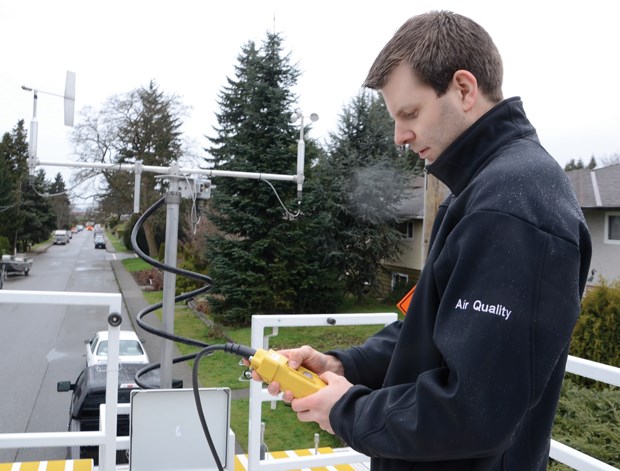Spring is in the air in Moodyville. There's also likely some diesel soot, coal dust and grain particulate.
Exactly how much of that stuff is in the air is now under study by Metro Vancouver's mobile air monitoring unit, commonly referred to as MAMU. Metro Vancouver parked the vehicle loaded with air-sniffing instruments on East Second Street last week and is hoping to keep it parked for the next six months to study air quality before expansion projects at Neptune Terminals, Richardson International and Low Level Road are complete.
"They are in the process of amending their air quality permit with Metro Vancouver, and getting a sense of the baseline (pollution) in advance of the expansion gives us a good handle on what sorts of mitigation measures are going to be needed and the conditions of that permit to ensure protection of the environment," said Roger Quan, Metro's director of air quality and environment.
The instruments are able to measure and differentiate between the different types of particulate in the air, whether it's dust coming off piles of grain and coal being loaded, or out of diesel engines from cargo ships, locomotive engines and trucks on Low Level Road.
The MAMU unit joins permanent air quality stations located near to the Ironworkers Memorial Second Narrows Crossing, Mahon Park and Horseshoe Bay.
The MAMU is welcomed by Tony Valente, chairman of the City of North Vancouver's Low Level Road and port area community liaison committee.
Metro decided to bring the MAMU to Moodyville at the request of the committee, which, along with the City of North Vancouver and Vancouver Coastal Health, has been lobbying Port Metro Vancouver to conduct a full health impact assessment. The port has rejected that request on the grounds that health concerns are already addressed in the federal environmental permitting process.
"It's part of us building these third-party, objective baselines. That's what our committee called for in our goal statement," Valente said.
"People have questions and this is going to help provide them with some answers."
The port's consultants have done theoretical modelling of the emissions and pollutants but those need to be verified, Quan said.
"At the end of the day, the model is a theoretical model. We need to do the monitoring to make sure the impacts that have been predicted by the model are actually what's happening in the community," he said.
If the diesel, carbon or particulate is at levels much higher than expected or at levels not safe for human or environmental exposure, different management practices or more control measures will be required, Quan said.



